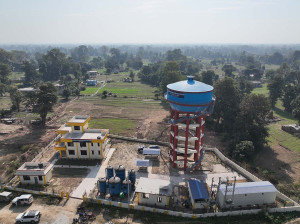Money
As festivals near, onion prices soar
On Monday, the wholesale price of onion in the Kalimati vegetables market was Rs128 per kg. In retail, it costs Rs170 to Rs180 per kg.
Post Report
As festival season nears, onion prices have risen over the past month and could climb even further, according to market analysts.
The price of the major kitchen staple has increased due to the rise in India, Nepal’s key source market.
According to Indian media reports, onion prices have risen to over IRs70 per kg in retail in Delhi and IRs80 per kg in other regions.
With retail onion prices now hovering over 47 percent higher than a year ago, India’s Union Food Minister Pralhad Joshi flagged off vans of two government cooperatives—the National Cooperative Consumer’s Federation (NCCF) and the National Agricultural Cooperative Marketing Federation—to sell onions at IRs35 per kg.
The Indian central government typically steps in when prices of onions, a politically sensitive commodity, start to climb. Every year, in the latter part of the monsoon, the onion crop gets damaged in key producing areas, leading to scarcity and price rises.
The price increase in India has a direct impact on Nepal, which is heavily dependent on onion imports from its southern neighbour.
Onions are cultivated three times a year in India—in monsoon, winter and summer.
According to the comparative price index of the Kalimati Fruits and Vegetable Market Development Board, the wholesale price of onion has increased by 20.32 percent within a month and by 71.29 percent within a year.
On Monday, the wholesale price of onion in the Kalimati market was Rs128 per kg, compared to around Rs70 per kg a year ago.
In retail, it costs Rs170 to Rs180 per kg.
“The price has increased in India, which automatically affects the price in the Nepali market,” said Mohan Baniya, president of the Potato-Onion Import-Export and Wholesaler Association.
“The price will start to cool down once the new harvest starts arriving in the Nepali market,” he said, adding that it would take a month for the new harvest to come in.
“Until then, the wholesale price will hover around Rs130 per kg.”
Traders say that in retail, onion may reach Rs200 per kg due to customs duties and other taxes.
“In India, onions cost around Rs65 per kg, and after adding Rs45 customs duty, it costs Rs110, excluding transportation,” said Baniya.
For consumers, price hikes on essential commodities, especially when the festival is around the corner, are a major concern.
“Without onion, it is impossible to prepare many dishes,” said Banshi Acharya, a resident of Ravi Bhawan, who was buying vegetables in the Kalimati market on Saturday.
“The price of daily essentials increases even with mere rumours. This shows a failure in the government’s ability to control market malpractices.”
Onion arrivals in the Kalimati market have declined by 31.77 percent within a month. The market received 24 tonnes of onion on Friday.
Onion imports declined by 68.14 percent in the last fiscal year, which ended in mid-July, compared to the corresponding period in the previous fiscal year.
According to the Department of Customs, Nepal imported 51,544 tonnes of onions worth Rs2.15 billion in the last fiscal year.
The Indian government banned onion exports in December last year and lifted the ban in May. However, India imposed a minimum export price of $550 per tonne, which caused a price hike in onions.
Despite the five-month ban, the supply of onions in the Nepali vegetable market remained stable as onions continued to arrive through informal channels, traders say. “Despite the ban, prices stayed stable due to rampant smuggling.”
In the last fiscal year, after the government imposed a 13 percent VAT on vegetables, including onions and potatoes, there were substantial price differences for onions in Nepal and India, which fuelled informal cross-border trade of onions, according to several reports. Nepal Police seized thousands of tonnes of onion smuggled in through the southern border, the reports say.
Prices, eventually, started to cool down as smuggling surged.
Even though Nepali customs officials regularly inspect the border, onions continued to be smuggled, particularly on motorbikes.
According to research titled ‘Dynamics of informal cross-border trade in agricultural products between Nepal and India,’ prepared by South Asia Watch on Trade, Economics and Environment (SAWTEE) in partnership with the International Food Policy Research Institute, India's ban on rice and other agricultural exports has led to massive smuggling of food from the 1,800 km porous border between Nepal and India Nepal in the south, east and west.
“India’s share in Nepal’s imports in formal trade is 60 percent, but the shares and volumes of informal trade are likely to be higher,” the research says.




 15.12°C Kathmandu
15.12°C Kathmandu














